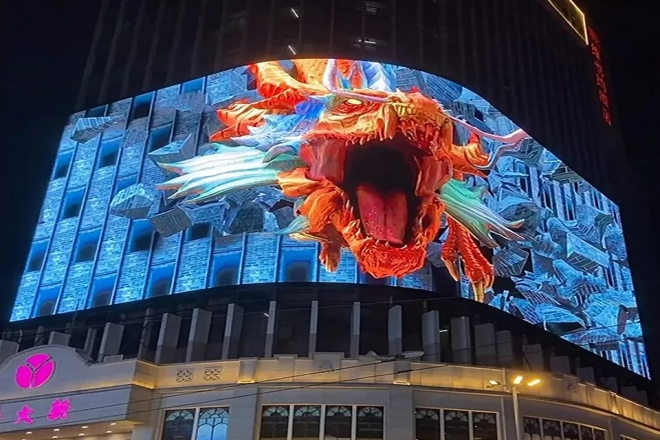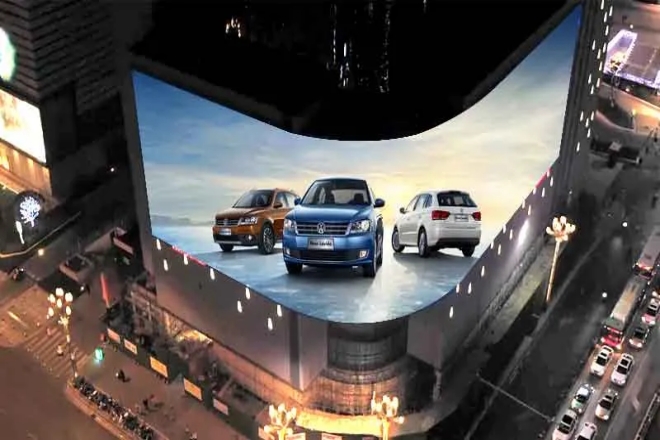Introduction

With the rapid development of visual technology, 3D LED displays have become a new favorite in advertising, exhibitions, entertainment, and other fields, and they have unique three-dimensional display effects.
It can not only provide shocking visual effects but also enhance the audience’s immersion and interactivity, bringing unprecedented publicity effects and market competitiveness to enterprises and brands. However, before purchasing a 3D LED display, it is crucial to clarify a series of conditions and requirements.
These conditions not only affect whether the performance of the display meets expectations but also directly affect the subsequent installation, use, and maintenance costs. Therefore, this article aims to explore in depth the conditions that need to be met before purchasing a 3D LED display to help you make a wise choice in the complex market.
1. Space and viewing angle design for the installation of 3D LED displays

When you want to install a 3D LED display, regarding the space and viewing angle design, we need to consider the following aspects to ensure that the display can maximize the 3D effect and enhance the audience’s viewing experience.
1). Space layout
- Determine the installation space
First, accurately measure and determine the size of the space where the display will be installed. This includes the length, width and height, as well as possible obstacles in the space, such as walls, columns or other equipment.
- Plan the audience area.
Plan a suitable audience area based on the expected number of viewers and their viewing habits. This helps determine the best position and angle of the display so that all viewers can get a good viewing experience.
- Consider ventilation and heat dissipation.
LED displays generate a certain amount of heat when working, so make sure there is enough ventilation in the installation space to avoid overheating of the display and affect its performance and life.
2). Viewing angle design
- Optimal viewing distance and angle
The viewing effect of 3D LED displays is greatly affected by viewing distance and angle. Generally speaking, the audience should be within the optimal viewing distance of the display and maintain an appropriate viewing angle to obtain the best 3D effect.
This distance and angle need to be determined according to the specific specifications of the display and the installation environment.
- Multi-angle viewing experience
In order to ensure that viewers in different positions can get a good viewing effect, you can consider using a curved screen or a rotatable display in the design to meet the viewing needs of different angles.
- Avoid blind spots
During installation, be careful to avoid forming blind spots or dead angles around the display, which may affect the viewing experience of some viewers. The appearance of blind spots can be reduced by adjusting the position, angle, or shape of the display screen.
3). Light and reflection control
- Light management
The display effect of the display screen is greatly affected by the ambient light. When installing, the surrounding light environment should be considered, and appropriate measures should be taken to reduce the interference of external light on the display screen.
For example, blackout curtains, blackout panels, or indoor lighting adjustments can be used to reduce the impact of light on the display screen.
- Anti-glare design
In order to improve the viewing comfort of the audience, the surface of the display screen should be made of anti-reflective materials and minimize glare and reflection. In addition, it is also possible to consider installing an anti-glare screen in front of the display screen or using a special optical film to further reduce the impact of glare and reflection.
4). Safety and maintenance
- Structural stability
The installation structure of the display screen must be stable and reliable, able to withstand the weight of the display screen and possible external factors such as wind.
Before installation, structural reinforcement and safety testing should be carried out to ensure that the display screen will not collapse or be damaged due to external forces after installation.
- Maintenance and care
In order to maintain the good performance of the display screen and extend its service life, regular maintenance and care are required. This includes cleaning the surface of the display screen, checking the connection lines, replacing damaged parts, etc. At the same time, emergency plans should be formulated to deal with possible emergencies.
2. Prepare the 3D video source that the 3D LED display must have
Just like the TV at home needs TV programs to play, the 3D LED display also needs specific video content to show its 3D effect. This special video content is a 3D video source. Without it, the display is like a canvas without content and cannot show its unique charm.
1). How do you get the 3D video source?
1.1). There are several ways to get 3D video sources:
Make it yourself: If you have professional shooting equipment and technology, you can shoot and make 3D videos yourself. This usually involves using a special 3D camera to capture the picture and adjusting and optimizing the effect in post-production.
Buy or rent: There are many professional video production companies or suppliers that provide ready-made 3D video sources for you to choose from. You can buy or rent this video content according to your needs.
- Download online: Some websites or platforms will provide free or paid 3D video materials for you to download and use. However, pay attention to copyright issues and make sure that the video content you use is legal.
2). Notes
Compatibility: Make sure the format of the 3D video source is compatible with the playback system of the 3D LED display. Common video formats include MP4, AVI, MOV, etc., but the specific supported formats may vary depending on the display model and playback system.
Testing: Before formal use, it is best to test the 3D video source to ensure that it can be played correctly on the display and present a good 3D effect.
Backup: For important 3D video sources, a backup should be made to prevent loss or damage.
3. The installation environment of the 3D LED display must be safe and stable

For the installation of 3D LED displays on large occasions (such as exhibitions, performances, etc.), their safety and stability are crucial. The following is a detailed explanation of how to ensure the safety and stability of the installation environment of 3D LED displays from multiple aspects:
1). Structural safety
1.1). Steel structure design:
Load-bearing capacity: Ensure that the steel structure can bear the weight of the display and its ancillary equipment while considering external factors such as wind load. The steel structure should undergo strict structural mechanics calculations to ensure its stability.
Foundation treatment: For outdoor installation, foundation treatment is particularly critical. The foundation should be flat and solid, and be able to withstand various forces during the operation of the display screen.
Solid connection: All connection points must be firm and reliable to avoid loosening or falling off during use.
1.2). Material selection:
Use high-strength and corrosion-resistant materials, such as carbon fiber, magnesium alloy, and other new materials, to reduce weight and improve the overall safety of the structure.
2). Electrical safety
- Power supply selection:
Choose a stable and reliable power supply to ensure that the power supply voltage is stable and the fluctuation does not exceed the specified range. For high-power display screens, a special distribution cabinet should be set up and equipped with a leakage protection device.
Electrical wiring should comply with relevant national standards to avoid safety hazards such as short circuits and leakage.
- Lightning protection design:
Install lightning protection devices on the display screen and buildings to prevent lightning strikes from damaging the display screen.
At the same time, good equipotential connections should be made to ensure that the internal insulation of the equipment and the overvoltage counterattack of the cable core wire are effectively controlled.
3). Fire safety
- Flame retardant materials:
The display screen and its ancillary equipment should use flame-retardant materials to reduce the risk of fire.
- Temperature monitoring:
Install temperature monitoring equipment to monitor the internal temperature of the display screen in real-time. Once the temperature is too high, the cooling system will automatically start, or an alarm will sound to prevent fire caused by overheating.
4). Environmental adaptability
- High temperature and high humidity environment:
The display screen should have a good cooling system, such as fans, heat sinks, etc., to ensure normal operation in high temperature environments. At the same time, take moisture-proof measures to prevent internal electronic components from being damaged by moisture.
- Strong wind environment:
Ensure that the display screen structure is stable and can withstand severe weather conditions such as strong winds. Consider wind load factors in the design and carry out corresponding reinforcement treatment.
5). Maintenance and repair
- Regular inspection:
Regularly inspect and maintain the display screen, including electrical connections, structural stability, cooling systems, etc. Discover and deal with potential safety hazards in a timely manner.
- Spare parts preparation:
Prepare sufficient spare parts and professional repair tools so that they can be quickly repaired in case of failure.
Conclusion
In summary, purchasing a 3D LED display screen is a complex and meticulous process, which requires clear usage scenarios and needs, reasonable budget planning, an in-depth understanding of technical performance, careful selection of suppliers and brands, and consideration of installation and after-sales and other conditions.
Only in this way can we ensure that we can purchase a 3D LED display screen with high-cost performance, stable performance, and high-quality service, which can provide strong support for subsequent visual display work.
Finally, if you want to know more about LED display screens, please get in touch with us.
